1. 植物-昆虫相互作用
Plant-insect interactions
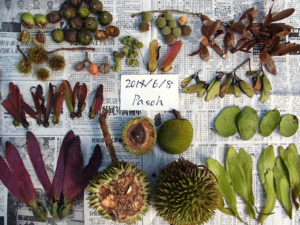
Various fruits found in a “General Flowering” event at Pasoh, Malaysia

A weevil feeding on dipterocarp seed
昆虫は全生物種の半分以上を占め、種数でも現存量でも地球上で圧倒的に繁栄しているグループです。特に、熱帯林は昆虫の多様性の宝庫であり、そこで昆虫は植物の繁殖や生存、養分の循環など森林の維持に関わる重要な役割を担っていることが分かってきています。当研究室では、マレーシアやシンガポールなどの熱帯雨林の種子食性昆虫に着目し、それらが植物の開花・結実フェノロジーや種多様性の進化に及ぼした影響について研究を行っています。
Insects occupy more than half of global biodiversity, overwhelming other taxonomic groups both in terms of number of species and biomass. In particular, insects are diverse in tropical forests and play a key role for maintaining the ecosystems by affecting reproduction and survivorship of plants and nutrient cycling. We are conducting researches on seed predators in tropical rainforests in Malaysia and Singapore to understand their importance as driving factors for evolution of flowering/fruiting phenology and species diversity of plants.
Hosaka et al. (2009) J Trop Ecol 25:625-636
Hosaka et al. (2011) J Trop Ecol 27:651-655
Hosaka et al. (2017) Biotropica 49:177-185, etc.
2. 林冠の生物多様性
Biodiversity at forest canopies
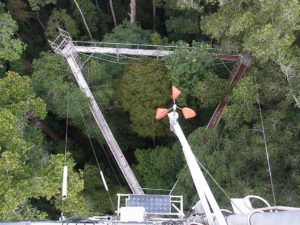
Canopy tower system at Pasoh, Malaysia

Survey on galling insects at tree crown 40 m above the ground
樹木の葉や花が生い茂る熱帯林の林冠部は、地上30-50mという高さが長年研究者のアクセスを阻んできたため、深海と並ぶ生態学的フロンティアと呼ばれていました。しかし近年、林冠部にアクセスするためのタワーやクレーンが熱帯林の多くのサイトで整備されたり、ロープクライミングなどの比較的簡便な木登り技術が普及したりしたことにより、林冠部の研究も手の届かないものではなくなってきました。私達は熱帯雨林の林冠部におけるゴール(虫こぶ)形成昆虫の多様性の調査など、林冠部の生物多様性解明に向けた研究を行っています。
Tropical rainforest canopies, where leaves and flowers are most abundant, had been poorly studied due to its extreme height, often 30-50 m above ground, and called as an ecological frontier like deep sea. Recently, however, canopies have become more accessible due to construction of tower and crane at many study sites and spread of tree climbing techniques. We are conducting studies to reveal diversity of insects (such as galling insects) at forest canopies.
Takagi et al. (2005) Insecta Matsumurana New Series 62:123-151
Hosaka et al. (2009) Tropics 18:93-102, etc.
3. 森林管理と生物多様性
Forest management and biodiversity
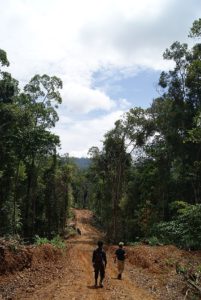
Logged forest at Temengor, Malaysia
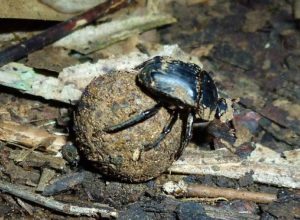
A dung beetle rolling dung ball
世界中の森林の大部分が保護林ではなく木材生産を目的とした生産林として管理されている現在、生物多様性の保全を効果的に行うためには、生産林においても生物多様性に配慮した森林管理が求められています。私達は、持続的な森林管理に向けて,木材伐採やそれに伴う林道建設がフン虫や小型哺乳類などの生物多様性や生態系機能に与える影響やその改善法に関して研究を行っています。
Because majority of tropical forests are managed not for protection but for timber production, biodiversity should be taken into consideration in managements of these production forests to conserve global biodiversity effectively. We are conducting studies on how timber logging and associated forest-road construction affect biodiversity (such as dung beetles and small mammals) and ecosystem functions of tropical forests, and how we can mitigate the negative impacts, toward sustainable forest management.
Hosaka et al. (2014) For Ecol Manage 326:18-24
Hosaka et al. (2014) Biotropica 46:720-731
Yamada et al. (2016) Biol Conserv 194:100-104, etc.
4. 人間―自然相互作用:生物多様性や自然景観に対する人々の意識,人間と野生生物の軋轢,自然ツーリズム
Human-nature interaction: People’s perception toward biodiversity and landscape, Human-wildlife conflict, Nature-based tourism
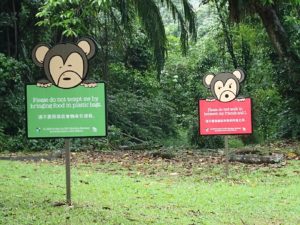
Sign board to avoid human-macaque conflict at Bukit Timah National Park, Singapore
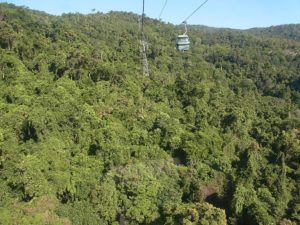
Tourism development at Kuranda tropical rainforest, Australia
生態系や生物多様性の保全は、突き詰めると、それらの価値を認識し保全したいと思う人々の意思に依存すると考えます。したがって、人々の生態系や生物多様性に対する嗜好性や意識を理解することは、効果的な保全政策の立案に不可欠です。特に,人間と野生生物との軋轢はしばしば保全活動上の障壁となります。私達は、自然景観や生物多様性に対する人々の意識や軋轢の構造に関する研究を行っています。また、人間活動と生態系保全の両立を可能にするツールとして、持続可能な自然ツーリズムに関する研究を行っています。
Nature conservation would be ultimately depending on people’s value for nature and willingness for conservation. Therefore, understanding people’s attitudes and perception toward nature is critically important for effective conservation planning. In particular, human-wildlife conflicts can often be an obstacle to conservation. We are conducting studies on people’s perception toward biodiversity and natural landscape and factors affecting the perception in tropical countries. We are also conducting studies on sustainable nature-based tourism as a tool for balancing human activities and ecosystem conservation.
Hosaka et al. (2016) Sci Rep 6:30911
Hosaka et al. (2016) Amer Entomol 62:228-234
Hosaka et al. (2017) Plos One 12: e0175243
Hosaka et al. (2018) Landsc Urban Plan 180:1-4, etc.
5. 都市の生物多様性とその保全
Urban biodiversity and its conservation
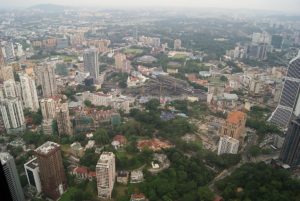
View of Kuala Lumpur city, Malaysia
「自然」は人里離れた遠隔地にのみ存在するものではありません。都市郊外や都心にも様々なタイプの「自然」が存在します。現在、世界的に都市化が進んでおり、生態系への影響が懸念されております。特に、多くの熱帯林を抱える発展途上国において、都市の拡大や人口集中が加速化しており、これらは直接的・間接的に熱帯林やその生物多様性に影響を与えると考えられます。私達は,都市化が生物多様性や人間-自然相互作用に及ぼす影響について研究を行います。
“Nature” are not necessarily located in remote areas. We can also find various types of “nature” in suburban and urban areas. Today, urban areas are expanding and urban population is increasing rapidly worldwide, and in particular, developing countries which holds majority of tropical forests. Therefore, we conduct studies on how urbanization affects biodiversity and human-nature interactions.
Azmy et al. (2016) Urban For Urban Gree 18:117-125
Hosaka et al. (2017) Palgrave Comm 3:17071
Muslim et al. (2018) Ecol Process 7:18, etc